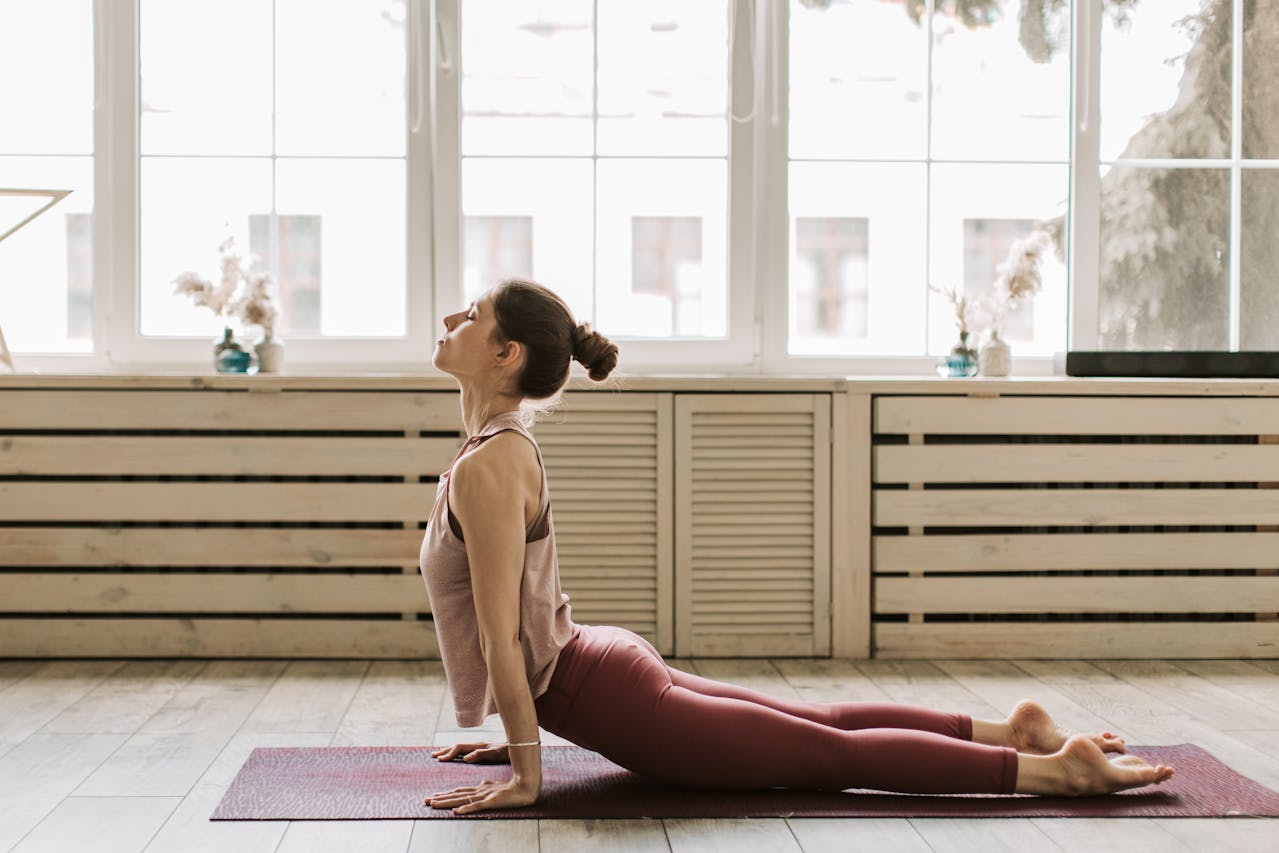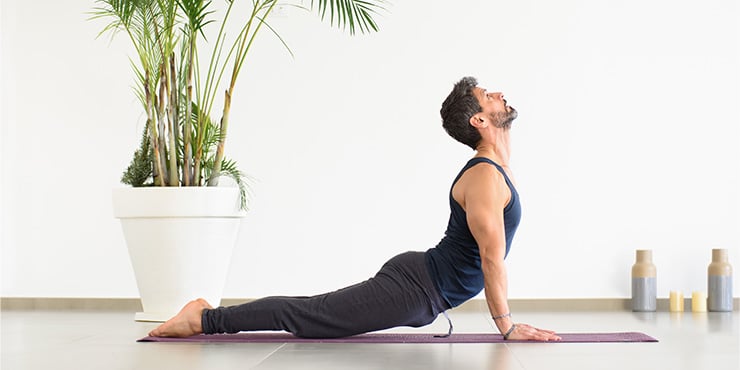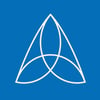
Table of Contents
Urdhva Mukha Svanasana, also known as upward-facing dog pose, is a foundational backbend posture commonly practiced in yoga. It strengthens the arms, shoulders, and back muscles while stretching the chest and abdomen.
Urdhva Mukha Svanasana
Urdhva Mukha Svanasana, also referred to as Up Dog or Upward-Facing Dog Pose, is a pose performed in yoga that involves an upward backbend. The posture maintains straight arms with the shoulders aligned over the wrists while bringing the hips forward and down towards the hands. The legs should be extended straight back with the tops of the feet touching the floor.
This pose is one of the most common poses incorporated into variations of Surya Namaskar, also known as Sun Salutation, and is common in vinyasa or flow-style yoga classes. However, it is also beneficial as a standalone pose. The name of the pose, Urdhva Mukha Svanasana, comes from the Sanskrit language and translates to "upward-facing dog." "Urdhva" means upwards, "Mukha" means facing, and "Svana" means dog.
Benefits of Urdha Mukha Svanasana
Urdhva Mukha Svanasana, or Upward-Facing Dog Pose, is an energizing ashtanga yoga pose that benefits the entire body. Some of the benefits include:
- Strengthens the spine: Urdhva Mukha Svanasana contributes to upper body strength and is beneficial for those who spend long hours sitting.
- Stretches the chest and lungs: As the spine stretches, the chest and lungs open, which improves breathing and increases lung capacity.
- Improves posture: Regular Urdhva Mukha Svanasana helps improve body posture by strengthening the upper back muscles.
- Stimulates abdominal organs: This asana boosts the internal organs, including the liver, kidneys, and pancreas, which aids digestion.
- Relieves mild depression and fatigue: The pose produces hormones that control the central nervous system, releasing tension and stress.
- Enhances overall flexibility: Urdhva Mukha Svanasana can help to improve flexibility, particularly in the spine, hips, and thighs.
In addition to these mental and physical benefits, Urdhva Mukha Svanasana has ties to the Anahata chakra, also known as the heart chakra. This is because the posture involves opening and expanding the chest, which activates and balances the heart chakra, leading to feelings of love, compassion, and connection with others.
Contraindications for Urdhva Mukha Svanasana
There are several contraindications to practicing Urdhva Mukha Svanasana or Upward Facing Dog Pose. Practitioners should consult with a qualified yoga teacher or medical professional if there are any concerns or pre-existing medical conditions. Common contraindications include:
- Wrist and neck injuries: Upward Facing Dog Pose can pressure the wrists and neck, and those with injuries in those areas should avoid the pose.
- Back pain or injury: Individuals with a history of back pain or injury should approach Urdhva Mukha Svanasana cautiously and avoid excessive back bending.
- Pregnancy: Pregnant women should avoid deep backbends, especially in the later stages of pregnancy when the belly is more prominent.
- High blood pressure: Upward Facing Dog Pose can cause a significant increase in blood pressure, making it dangerous for those with high blood pressure or heart problems.
- Carpal Tunnel Syndrome: Individuals with Carpal Tunnel Syndrome should avoid this pose or modify it by keeping the elbows bent and the forearms on the ground.
- Herniated discs: Individuals with herniated discs should avoid or modify this pose, as excessive back bending can cause further damage to the spine.
Preparing for Upward Facing Dog
Salabhasana, or Locust Pose, is a valuable pose to practice for those preparing for Upward Facing Dog. This pose lifts the upper body and head, allowing practitioners to activate their spinal erectors and memorize the feeling required for Upward Dog. Raising the legs in Salabhasana can also help recreate the necessary sensation for Upward Facing Dog.
Another preparatory pose that is similar to Upward Facing Dog is Cobra Pose. In Cobra Pose, practitioners keep their hips on the floor while bending their elbows. This pose can be helpful for those still developing the strength and flexibility required for Upward Facing Dog.
Step-by-step Instructions for Upward Dog
Here are the step-by-step instructions for Urdhva Mukha Svanasana:
- Begin by lying face down on your mat with the legs extended behind you and the tops of your feet resting on the floor. Place the hands on the floor alongside the ribs, with the elbows bent and pointing toward the ceiling.
- Inhale and push the body weight into the hands and the tops of your feet as you lift your head, chest, and thighs off the floor. Straighten your arms as you lift your torso, but keep your thighs on the floor.
- Roll your shoulders back and down away from your ears, and broaden your collarbones. Gaze straight ahead or slightly upward, and avoid compressing the back of your neck.
- Keep your thighs and glutes engaged while lifting the chest and gaze upward. Draw your shoulder blades toward each other, and lift your sternum toward the ceiling.
- Hold the pose for 5-10 breaths. To release, exhale and slowly lower your torso and thighs back down to the floor.
Note: It's important to avoid compressing the low back in this pose. If one feels any discomfort or strain in their low back, modify the pose by lowering the thighs to the floor or coming into a gentler backbend.
Entering Upward Dog from Chaturanga
When transitioning from chaturanga to upward-facing dog pose, start by pointing the feet back, so the tops of the feet touch the floor. Then, pull the chest forward and up while straightening the arms and pulling the forearms towards the body. During this transition, adjust the feet as necessary.
Actively press the feet down into the floor while keeping the knees straight. Bend back at the hips by pushing the hips forward and down without letting them touch the floor. This body alignment activates the spinal erectors and the abdominal muscles.
Effective arm use involves adjusting the shoulders forwards or back to find a comfortable position. The amount of upper arm rotation can provide stability and balance. Experiment with the right amount of shoulder depression or ribcage lift to ensure proper alignment and form in upward facing dog pose. Take time to rest if needed.
Strengthening Shoulder Stability
One can improve shoulder stability by activating their forearms and upper arms. The first step is to rotate the front of the elbows outwards, which will help open the shoulders. To enhance this effect, one can also pull the bottom tips of the shoulder blades outward, almost as though tucking them into the armpits. This movement may cause the top of the shoulders (the acromion process) to move backward.
Practitioners should compress the collar bones to improve control and strengthen the shoulders. They can also strengthen shoulder stability by engaging the clavicular portion of the pectoralis major without allowing the collar bones to move forward. By combining these techniques, one can develop greater shoulder stability and control.
From Upward Dog to Downward Facing Dog Pose
Following upward facing dog pose in a sequence, the next pose is often downward facing dog pose, known as adho mukha svanasana. This is one of many counter poses that pairs well with upward dog. To transition into downward dog, keep the toes tucked and use the arms to push the ribcage back while simultaneously pressing the hips up. You can use the arms to assist in pushing the upper body back or engage the leg muscles to pull the hip flexors back.
A Guide to Urdhva Mukha Svanasana
 Understanding the Spinal Erectors
Understanding the Spinal Erectors
To experience the sensation of spinal erector muscles, an individual can lift their head and ribcage without using arms. They should elongate their neck by drawing their ears away from their shoulders. Lift the palms off the floor to prevent using the arms. Repeat this process several times, lifting and relaxing slowly.
Instead of sudden lifts, the head should lift slowly, followed by the ribcage. While lifting the ribcage, individuals should pull their back ribs towards their buttocks and the front of their ribs towards their chin. To increase activation of spinal erectors, an individual should maintain the backward bend in their spine and actively draw the stomach in as if attempting to straighten their spine.
Engaging the Legs
Practitioners should keep the legs engaged in Urdhva Mukha Svanasana by lifting their head and ribcage without using their arms. Next, they can place their hands on the floor and press the tops of their feet down firmly while keeping their knees straight and arms close to their body. Keeping the legs active throughout the pose is essential to fully engage the lower body and support the spine.
Individuals can then use their arms to lift their upper body, increasing the backbend in their spine and hips while keeping their spinal erectors and abdominal muscles engaged. They can stop short of their hips lifting and keep their elbows bent in Cobra Pose or Bhujangasana.
Activating the Shoulder Blades
To activate the shoulders, one can externally rotate the upper arms and resist the rotation to pull the bottom tips of the scapulae outwards. This creates a downward pull on the inside edges of the scapulae, causing the top points to move backward. One can use the shoulders to lift or lower the torso relative to the shoulders slightly.
Activating the Forearms and Elbows
To work on achieving straight elbows, one can focus on forearm and elbow activation. Starting from the torso-lifted position with hips on the floor, spread the fingers and accentuate the activation of the forearms. Then, activate the elbows and shoulders. With practice, engaging the arms from fingers to shoulders becomes easier, which helps straighten the elbows for a full upward-facing dog pose or Urdhva Mukha Svanasana. One should take a break whenever needed.
Engaging the Lower Ribs
It is important to support the thoracolumbar junction and control the lower half of the ribcage to prevent low back pain in upward dog pose and other similar situations. One way to achieve this is to generate an inward pull on either side of the arch by pulling the left side towards the right and the right side towards the left. This activates the serratus posterior inferior muscles, which can help stabilize the thoracolumbar junction and the lower half of the ribcage.
Another method to activate the lower ribs is by creating a downward and inward pull on the backs of the lowest three pairs of ribs. Practice this technique while kneeling or standing upright before trying it in upward dog pose. Avoiding flaring out the lower ribs adds support to the thoracolumbar junction. Remember to take a break whenever necessary.
Engaging the Neck
To begin Upward Facing Dog Pose, lengthen the back of the neck and maintain a straight gaze. Activate the legs and engage the spinal erectors and arms. While moving into the pose, experiment with the position of your shoulders relative to your ribcage, finding a comfortable place. Adjust the amount of lift in your ribcage. When bending your neck backward, do so gradually and smoothly to avoid strain or injury.
Activate the Front of the Neck
To activate the cervical spinal erectors while bending the neck backward in Upward Facing Dog Pose, one should first activate the front of the neck. Focus on keeping the front of the neck engaged during the backward bend or activate the muscles at the front of the neck after bending the neck backward. One can create a downward pull on the collar bones relative to the ribcage to anchor the endpoint of the neck muscles, such as the sterno-cleido mastoid. To anchor the upper and middle fibers of the trapezius muscle, exert a downward pull on the acromion processes.
References
Upward-Facing Dog Pose: How to Practice Urdhva Mukha Svanasana
Understanding and Preventing Yoga Injuries
Disclaimer
The contents of this article are provided for informational purposes only and are not intended to substitute for professional medical advice, diagnosis, or treatment. It is always recommended to consult with a qualified healthcare provider before making any health-related changes or if you have any questions or concerns about your health. Anahana is not liable for any errors, omissions, or consequences that may occur from using the information provided.

By: Anahana
The Anahana team of researchers, writers, topic experts, and computer scientists come together worldwide to create educational and practical wellbeing articles, courses, and technology. Experienced professionals in mental and physical health, meditation, yoga, pilates, and many other fields collaborate to make complex topics easy to understand.
